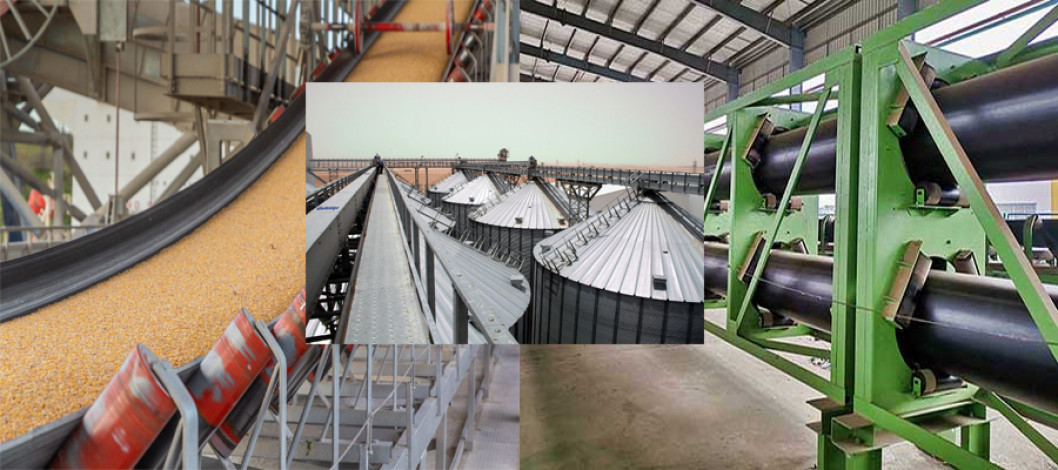
File photo
Those deeply involved in the grain
handling industry know how important it is to have a reliable and efficient
system for handling their grain. Whether you are storing wheat, corn, soybeans,
or other grains, an effective silo grain handling and transportation system is
essential to maintaining quality and ensuring smooth operation from storage to
transportation.
A silo grain handling transportation
system is fundamental to storing grain efficiently and safely. These systems
are designed to transport grain from one location to another, prevent
contamination, and maintain the quality of stored grain. Whether you are
operating a large-scale storage facility or a small operation, understanding
the components and benefits of these systems can significantly improve your
workflow. Let’s learn about the basics of silo grain handling and explore how
this system can benefit your operation.
What is a silo grain handling conveying
system?
A silo grain handling conveying system
is a critical component in the storage and transportation of bulk grain. It
efficiently transfers grain from various receiving locations, such as trucks or
railcars, to a storage silo and retrieves it later when needed. There are
several key components in this system, each playing a critical role in ensuring
the efficiency and safety of the grain handling process.
Key Components of a Silo Grain Handling
Conveying System
Silo:
Silos are large, cylindrical storage
containers used for storing bulk grain. Made of steel or concrete, these
structures come in a variety of sizes and are equipped with ventilation systems
to control temperature and humidity, maintaining optimal storage conditions.
Conveyors:
Conveyors are essential for transporting
grain in and out of silos. The most common types of conveyors include:
Belt conveyors: These are ideal for
horizontal or slightly inclined transport, providing continuous operation.
Bucket Elevators: Used for vertical
grain transport, they are efficient at moving grain to higher levels or silos.
Drag Conveyors: Suitable for horizontal
or inclined transport, these conveyors allow for smooth transfers between
different parts of a facility.
Discharge Systems:
Discharge systems, such as sweep augers
or chain conveyors, remove grain from the bottom of the silo and help transport
it to other areas. These systems ensure that the grain is emptied safely and
efficiently.
Feeding Systems:
Feeding systems ensure that grain is efficiently transferred to the silo. These systems may include drag or belt conveyors, transporting the grain from trucks or other receiving mechanisms to storage.
Benefits of Efficient Silo Grain
Handling Systems
Automation:
Many modern silo systems include
automation technology that allows for remote monitoring and control of grain
handling processes. This increases operational efficiency and reduces labor
costs.
Efficiency:
Automatic in-loading systems help speed
up the transfer of harvested grain into silos, reducing downtime during
harvest. For example, bucket elevators and drag conveyors can move grain into
storage quickly, preventing delays.
Quality control:
Silo systems often include ventilation
systems that maintain optimal conditions for grain storage, preventing spoilage
and preserving grain quality. These systems can monitor temperature, humidity, and airflow, so that grain remains fresh and usable for longer periods of time.
Flexibility:
The design of silo grain handling
systems allows for a variety of configurations to suit specific operational
needs. Whether you are working with horizontal, vertical or risky setups, these
systems can be adapted to the layout of your facility.
What are the latest innovations in grain
handling and transportation systems?
Innovation continues to drive
improvements in grain handling and transportation systems, with a particular
focus on automation, smart technology, and increased efficiency. Here are some
notable advances:
Larger storage
capacity
Grain storage systems are being designed with larger and more robust configurations, allowing for faster construction and more efficient use of space. Modern silos can hold much larger amounts of grain, which is important as production increases.
AI-powered grain sorting
AI-powered grain sorting systems use
machine learning and computer vision to detect contaminants, such as foreign
matter, damaged grain, or moldy grain. These systems work faster and more
accurately than manual sorting, ensuring that only the highest quality grain is
stored.
Automated grain drying systems
Automatic grain drying systems use
advanced sensors to monitor moisture content and adjust drying parameters in
real-time. These systems ensure that grain is optimally dried, preventing rot
and maintaining quality consistency.
Robotics and automation in conveyors
The integration of robotics and AI in
conveyor systems has improved material handling processes. Grain handling robots
can automate tasks such as assisting in grain storage, managing grain bins, and
even optimizing storage conditions by monitoring grain quality and temperature.
Smart Monitoring Systems
Advanced grain systems are now equipped
with sensors and automated controls that monitor temperature, humidity, and
airflow in real-time. These systems provide valuable data that helps optimize
storage conditions, reduce spoilage, and improve overall efficiency.
Energy Efficiency
Innovations in conveyor systems are also
focusing on energy efficiency. These solutions reduce power consumption and are
part of the move toward sustainable, smart material handling systems.
How does automation improve safety in
grain handling operations?
Automation has revolutionized safety in
grain handling operations by reducing manual labor in hazardous environments
and providing real-time monitoring of equipment. Here’s how:
Reduce injuries and lost time
Automated equipment, such as railcar
unloading mechanisms, protects workers from injury, significantly reducing the
incidence of injuries and lost time.
A silo grain handling transport system
is essential for effectively handling bulk grain, ensuring safe storage, and
improving operational efficiency. As the industry continues to innovate, the
integration of automation and smart technology is helping to streamline
processes, improve safety, and improve overall performance. Whether you are
looking to improve grain storage capacity, automate processes, or reduce safety
risks, investing in the right grain handling system can transform your
operation. With these comprehensive solutions, you can achieve an efficient,
safe, and reliable grain handling process tailored to your needs.
- SZK, Based on online information
Comment Now